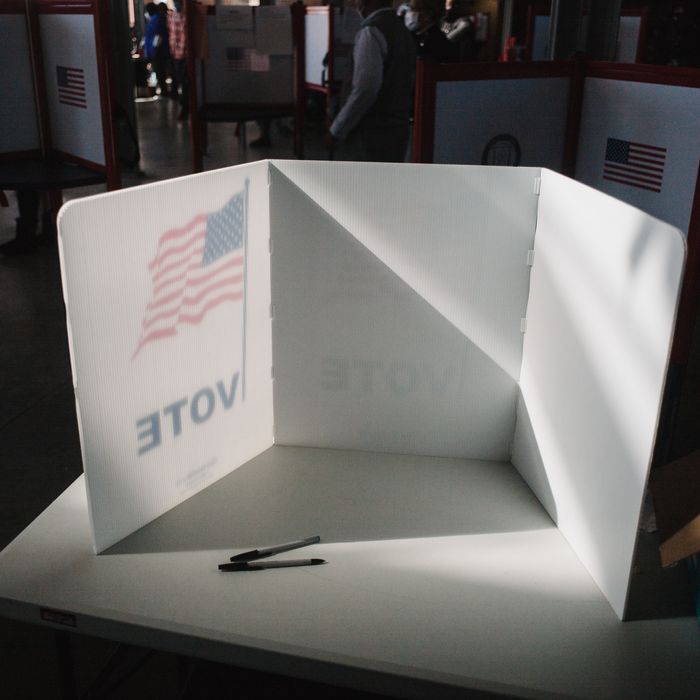If You Are a Centrist You Cant Ever Vote Republican Again

Voters are more likely to express interest in a third party than actually support 1. Photo: Scotty Perry/Bloomberg via Getty Images
An indelible fantasy most American politics is that our ossified and polarized ii-party arrangement may give fashion to a centrist 3rd party that volition rise to power on the frustrations of voters tired of gridlock and refusals to compromise in the national involvement. You lot hear this cry for a fresh option more and more as Republicans systematically deploy the filibuster to obstruct Joe Biden's agenda, and Joe Biden's Democrats cannot or will not chase Republicans around Washington with candy and valentines until deals are cut and things become done. Indeed, Gallup found earlier this year that a record-high 62 pct of Americans agreed that "the parties practice such a poor job representing the American people that a tertiary party is needed."
Only that's in theory, of course. In reality, a lot of Americans who say they are angry at the two-party arrangement are really only angry at the party opposing their own for failing to get out of the way or become off to die. And even if you could somehow get all the malcontents together in ane room, do they really speak the aforementioned ideological linguistic communication and concord on what is to be done when all the "getting things done" commences?
A new typology of American voters from the Pew Enquiry Center shows why a centrist 3rd party is problematic in the extreme. Afterwards request a very big sample of voters a battery of questions aimed at determining their partisan leanings and ideological tendencies, alongside positions on key issues, Pew came up with nine groups. Four (Progressive Left, Establishment Liberals, Democratic Mainstays, and Outsider Left) are Autonomous leaning, four more than (Faith and Flag Conservatives, Committed Conservatives, Populist Right, and Ambivalent Right) are Republican leaning, and 1 (Stressed Sideliners) leans neither way.
If you take the left and correct groups to the lowest degree intensely partisan (the Outsider Left and the Clashing Right) and add them to the nonpartisan Stressed Sideliners, you get a substantial 37 pct of the electorate, plenty to grade a plurality in close three-manner political contests. But there are two big obstacles to them becoming an constructive Third Forcefulness, notes Pew:
Surveys by Pew Enquiry Center and other national polling organizations have found broad support, in principle, for a tertiary major political party. All the same the typology study finds that the three groups with the largest shares of self-identified independents (well-nigh of whom lean toward a party) — Stressed Sideliners, Outsider Left and Ambivalent Right — have very picayune in common politically. Stressed Sideliners hold mixed views; Ambivalent Right are conservative on many economic bug, while moderate on some social issues; and Outsider Left are very liberal on most issues, especially on race and the social safe cyberspace.
These three groups do have one negative point of conjunction:
What these groups do accept in mutual is relatively low interest in politics: They had the lowest rates of voting in the 2020 presidential ballot and are less likely than other groups to follow government and public affairs most of the time.
So even if you designed a political party or a candidate that could somehow appeal to all of the politically dispossessed, many in the target audience might not find or wouldn't vote anyway. And if they did get motivated enough to consider the Third Strength, they might tear each other apart on the way to saving the land.
Ultimately, the purported constituents for a centrist third party aren't equally large a group as is often imagined and aren't really centrists, either. And their alienation from both parties may be more about alienation from politics or, to put information technology another way, from the prospect of doing anything near their grievances. This fantasy volition never dice, but it's not springing into real life in the foreseeable future.
Source: https://nymag.com/intelligencer/2021/11/why-there-is-no-centrist-third-party.html
0 Response to "If You Are a Centrist You Cant Ever Vote Republican Again"
Post a Comment